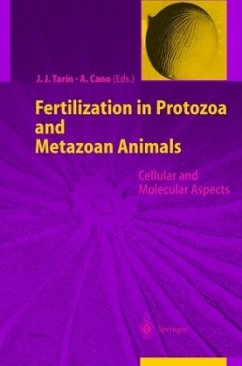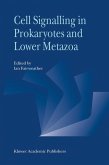Fertilization in Protozoa and Metazoan Animals
Cellular and Molecular Aspects
Herausgegeben:Tarin, Juan J.; Cano, Antonio
Fertilization in Protozoa and Metazoan Animals
Cellular and Molecular Aspects
Herausgegeben:Tarin, Juan J.; Cano, Antonio
- Broschiertes Buch
- Merkliste
- Auf die Merkliste
- Bewerten Bewerten
- Teilen
- Produkt teilen
- Produkterinnerung
- Produkterinnerung
Reproduction is the origination of new organisms from pre-existing ones. Among more than 35 separated forms of reproduction including several types of gamogony, parthenogenesis, agamogenesis, fission and division, and plas motomy, the bisexual mode of reproduction via fertilization provides genetic variability that allows species to adapt quickly to competitive and constantly changing environments. Several excellent reviews and books have been written in the past to analyse the mechanisms of fertilization in different eukaryotic species. During the last few years, however, renewed attention…mehr
Andere Kunden interessierten sich auch für
![Molecular Evolution: Evidence for Monophyly of Metazoa Molecular Evolution: Evidence for Monophyly of Metazoa]() Molecular Evolution: Evidence for Monophyly of Metazoa74,99 €
Molecular Evolution: Evidence for Monophyly of Metazoa74,99 €![Insect Accessory Reproductive Structures Insect Accessory Reproductive Structures]() M. S. KaulenasInsect Accessory Reproductive Structures77,99 €
M. S. KaulenasInsect Accessory Reproductive Structures77,99 €![A Review of Histogenesis/Organogenesis in the Developing North American Opossum (Didelphis virginiana) A Review of Histogenesis/Organogenesis in the Developing North American Opossum (Didelphis virginiana)]() William J. KrauseA Review of Histogenesis/Organogenesis in the Developing North American Opossum (Didelphis virginiana)77,99 €
William J. KrauseA Review of Histogenesis/Organogenesis in the Developing North American Opossum (Didelphis virginiana)77,99 €![Invertebrate Tissue Culture Methods Invertebrate Tissue Culture Methods]() Jun MitsuhashiInvertebrate Tissue Culture Methods98,99 €
Jun MitsuhashiInvertebrate Tissue Culture Methods98,99 €![Cell Signalling in Prokaryotes and Lower Metazoa Cell Signalling in Prokaryotes and Lower Metazoa]() Cell Signalling in Prokaryotes and Lower Metazoa154,99 €
Cell Signalling in Prokaryotes and Lower Metazoa154,99 €![Cell Signalling in Prokaryotes and Lower Metazoa Cell Signalling in Prokaryotes and Lower Metazoa]() FairweatherCell Signalling in Prokaryotes and Lower Metazoa154,99 €
FairweatherCell Signalling in Prokaryotes and Lower Metazoa154,99 €![Ion Transport in Vertebrate Colon Ion Transport in Vertebrate Colon]() Ion Transport in Vertebrate Colon77,99 €
Ion Transport in Vertebrate Colon77,99 €-
-
-
Reproduction is the origination of new organisms from pre-existing ones. Among more than 35 separated forms of reproduction including several types of gamogony, parthenogenesis, agamogenesis, fission and division, and plas motomy, the bisexual mode of reproduction via fertilization provides genetic variability that allows species to adapt quickly to competitive and constantly changing environments. Several excellent reviews and books have been written in the past to analyse the mechanisms of fertilization in different eukaryotic species. During the last few years, however, renewed attention has been paid to examining the process of oocyte fertilization at the cellular/molecular level not only within a single species/group but also through different phylogenetic lineages. As a result of this effort, knowledge of the molecular pathways used by oocytes and spermatozoa at fertilization has increased, but still many ques tions remain to be answered. Being aware of the necessity of providing an inte grated view of the process of fertilization, this book has been entirely devoted to reviewing the process of oocyte fertilization at the cellular/molecular level in two different and separated groups of eukaryotic organisms: protozoa and metazoan animals. The book is organized into six sections dealing with oocyte fertilization in protozoa, invertebrates, teleost fishes, amphibians, birds and mammals. These sections are followed by a summary/concluding chapter that provides a com parative overview of the process of fertilization in these groups of eukaryotes.
Produktdetails
- Produktdetails
- Verlag: Springer / Springer Berlin Heidelberg / Springer, Berlin
- Artikelnr. des Verlages: 978-3-642-63530-4
- Softcover reprint of the original 1st ed. 2000
- Seitenzahl: 340
- Erscheinungstermin: 5. November 2012
- Englisch
- Abmessung: 235mm x 155mm x 19mm
- Gewicht: 517g
- ISBN-13: 9783642635304
- ISBN-10: 364263530X
- Artikelnr.: 37478710
- Verlag: Springer / Springer Berlin Heidelberg / Springer, Berlin
- Artikelnr. des Verlages: 978-3-642-63530-4
- Softcover reprint of the original 1st ed. 2000
- Seitenzahl: 340
- Erscheinungstermin: 5. November 2012
- Englisch
- Abmessung: 235mm x 155mm x 19mm
- Gewicht: 517g
- ISBN-13: 9783642635304
- ISBN-10: 364263530X
- Artikelnr.: 37478710
1 Fertilization in Protozoa.- 1 Reproduction Strategies in Protozoa.- 1.1 Gametogamy.- 1.2 Autogamy.- 1.3 Gamontogamy.- 2 Fertilization in a Flagellate.- 2.1 Reproduction inChlamydomonas reinhardtii.- 2.2 Induction of Gametogenesis.- 2.3 Mating and Cell Fusion.- 2.3.1 Flagellar Agglutination.- 2.3.2 Losing Cell Wall and Protoplast Formation.- 2.3.3 Activation of Mating Structures.- 2.3.4 Formation of a Cytoplasmic Bridge.- 2.3.5 Protoplasmic Fusion.- 2.3.6 Nuclear Fusion, Flagellar Retraction and Zygotic Wall Formation.- 2.3.7 Chloroplast.- 2.4 Meiosis and Germination.- 3 Sexual Phase and Fertilization inPlasmodium.- 3.1 Reproduction inPlasmodium falciparum.- 3.2 Gametogenesis and Fertilization in the Mosquito.- 3.3 Asexual Development in the Mosquito and in the Human Body.- 3.4 The Sexual Phase.- 4 Gamogony and Agamogony in Foraminiferans.- 4.1 Life Cycle of Foraminiferans.- 4.2 Heterokaryotic SpeciesRotaliella heterocaryotica.- 4.3 Homokaryotic SpeciesPatellina corrugata.- 5 Conjugation in Ciliates.- 5.1 Life Cycle ofParamecium caudatum.- 5.2 Sexual Interaction at the Beginning of Conjugation.- 5.3 Nuclear Events During Conjugation.- 5.3.1 Nuclear Behavior at Early Stages of Conjugation and Meiosis.- 5.3.2 Random Selection of Meiotic Products.- 5.3.3 Gametogenesis and Fertilization.- 5.3.4 Macro-and Micronuclear Differentiation.- 5.3.5 Development of a New Macronucleus.- 5.3.6 Determination of the Germinal Micronucleus.- References.- 2 Fertilization in Invertebrates.- 1 Introduction.- 2 Porifera.- 2.1 Reproductive Strategies and Reproductive Cycle.- 2.1.1 Design of Reproductive System.- 2.1.2 Gametogenesis and Fertilization.- 2.2 Cellular and Molecular Aspects of Fertilization.- 2.2.1 Sperm.- 2.2.2 Oocytes.- 2.2.3 Fertilization.- 3 Cnidaria (Coelenterata).- 3.1 Reproductive Strategies and Reproductive Cycle.- 3.1.1 Design of Reproductive System.- 3.1.2 Gametogenesis and Fertilization.- 3.2 Cellular and Molecular Aspects of Fertilization.- 4 Ctenophora.- 4.1 Reproductive Strategies and Reproductive Cycle.- 4.1.1 Design of Reproductive System.- 4.1.2 Gametogenesis and Fertilization.- 4.2 Cellular and Molecular Aspects of Fertilization.- 5 Platyhelminthes.- 5.1 Reproductive Strategies and Reproductive Cycle.- 5.1.1 Design of Reproductive System.- 5.1.2 Gametogenesis and Fertilization.- 5.2 Cellular and Molecular Aspects of Fertilization.- 6 Rhynchocoela (Nemertea, Nemertinea).- 6.1 Reproductive Strategies and Reproductive Cycle.- 6.1.1 Design of Reproductive System.- 6.1.2 Gametogenesis and Fertilization.- 6.2 Cellular and Molecular Aspects of Fertilization.- 7 Nematoda.- 7.1 Reproductive Strategies and Reproductive Cycle.- 7.1.1 Design of Reproductive System.- 7.1.2 Gametogenesis and Fertilization.- 7.2 Cellular and Molecular Aspects of Fertilization.- 7.2.1 Sperm.- 7.2.2 Oocytes.- 7.2.3 Fertilization.- 8 Mollusca.- 8.1 Reproductive Strategies and Reproductive Cycle.- 8.1.1 Design of Reproductive System.- 8.1.2 Gametogenesis and Fertilization.- 8.2 Cellular and Molecular Aspects of Fertilization.- 8.2.1 Sperm.- 8.2.2 Oocytes.- 8.2.3 Fertilization.- 9 Annelida.- 9.1 Reproductive Strategies and Reproductive Cycle.- 9.1.1 Design of Reproductive System.- 9.1.2 Gametogenesis and Fertilization.- 9.2 Cellular and Molecular Aspects of Fertilization.- 10 Arthropoda.- 10.1 Reproductive Strategies and Reproductive Cycle.- 10.1.1 Design of Reproductive System.- 10.1.2 Gametogenesis and Fertilization.- 10.2 Cellular and Molecular Aspects of Fertilization.- 10.2.1 Sperm.- 10.2.2 Oocytes.- 10.2.3 Fertilization.- 11 Echinodermata.- 11.1 Reproductive Strategies and Reproductive Cycle.- 11.1.1 Design of Reproductive System.- 11.1.2 Gametogenesis and Fertilization.- 11.2 Cellular and Molecular Aspects of Fertilization.- 11.2.1 The Unfertilized Egg.- 11.2.2 Sperm.- 11.2.3 Sperm Activation.- 11.2.4 Fertilization.- 11.3 MPF and MAP Kinases During Meiotic Maturation and Fertilization.- 12 Protochordata.- 12.1 Reproductive Strategies and Reproductive Cycle.- 12.1.1 Design of Reproductive System.- 12.1.2 Gametogenesis and Fertilization.- 12.2 Cellular and Molecular Aspects of Fertilization.- 12.2.1 Sperm.- 12.2.2 Oocytes.- 12.2.3 Spawning of Gametes and Fertilization.- 12.2.4 Calcium Oscillations.- 12.2.5 Block to Polyspermy.- 12.3 MPF and MAP Kinases During Meiotic Maturation and Fertilization.- References.- 3 Fertilization in Fishes.- 1 Introduction.- 2 Structural Preparation of Oocyte and Spermatozoon for Fertilization.- 2.1 Egg.- 2.1.1 Chorion.- 2.1.2 Micropyle.- 2.1.3 Cortical Layer.- 2.1.4 Sperm Entry Site.- 2.1.5 Nucleus.- 2.2 Spermatozoon.- 3 Oocyte Maturation for Acquisition of Fertilizability.- 4 Interaction and Membrane Fusion Between Gametes.- 4.1 Behavior and Fertilizability of Spermatozoa.- 4.2 Sperm-Egg Interaction.- 4.3 Sperm-Egg Membrane Fusion.- 5 Responses of Egg to Membrane Fusion with Spermatozoon.- 5.1 Change in Membrane Potential.- 5.2 Fertilization Wave and Wave of Increase in Cytoplasmic Ca2+.- 5.3 Exocytosis of Cortical Alveoli.- 5.4 Mechanism of Propagative Increase in Cytoplasmic Ca2+and pH.- 5.5 Relationship Between Wave of Increase in Cytoplasmic Ca2+and Exocytosis Wave.- 5.6 Perivitelline Space Formation and Change in Chorion.- 5.7 Fertilization Cone and Sperm Incorporation.- 6 Polyspermy-Preventing Mechanism.- 7 Formation of Male and Female Pronuclei.- 7.1 Progression of Second Meiotic Metaphase to Interphase.- 7.2 Breakdown of Nuclear Envelope and Chromatin Decondensation.- 7.3 Pronucleus Formation and MPF Activity.- 7.4 DNA Synthesis and Pronucleus Formation.- 8 Migration and Karyogamy of Female and Male Pronuclei.- 9 Fertilization Without an Increase in Cytoplasmic Ca2+and Exocytosis of Cortical Alveoli.- References.- 4 Fertilization in Amphibians.- 1 Introduction.- 2 Interactions of Sperm with Oocyte Investments and Oocyte Membrane.- 2.1 Interactions of Sperm with Jelly Layers.- 2.2 Sperm-Binding to the Vitelline Envelope.- 2.3 Acrosome Reaction.- 2.4 Interactions Between Sperm-and Oocyte-Membranes.- 3 Mechanism of Oocyte Activation.- 3.1 [Ca2+]iIncrease.- 3.2 Fertilization Potentials.- 3.3 Cortical Reactions and Fertilization Envelope Formation.- 3.4 Resumption of Meiosis and Sperm Nuclear Decondensation.- 4 Mechanisms for Polyspermy Block.- 4.1 Role of Polyspermy Block.- 4.2 Reduction in Number of Sperm in Oocyte Investments.- 4.3 Fast, Electrical Block to Polyspermy.- 4.4 Slow Polyspermy Block by the Fertilization Envelope.- 4.5 Acquisition of Polyspermy Block During Oocyte Maturation in Anurans.- 4.6 Cytoplasmic Block to Polyspermy in Physiologically Polyspermic Oocytes.- 5 Variations in Amphibian Fertilization.- 5.1 Polyspermy in Anurans.- 5.2 Monospermy in Primitive Urodeles.- 5.3 Sperm Nuclear Behavior in Gynogenetic Urodele Oocytes.- References.- 5 Fertilization in Birds.- 1 Introduction to Avian Breeding Systems.- 2 Gametes, Gameteogenesis and Reproductive Systems.- 2.1 Primordial Germ Cells and Establishment of Gonads.- 2.2 Male Reproduction System and Sperm Production.- 2.2.1 Male Tract Anatomy.- 2.2.2 Maturation of Sperm Function.- 2.3 Female Reproductive System.- 2.3.1 The Ovary and Ovulation.- 2.3.2 The Oviduct and Egg Formation.- 2.4 Spermatozoa.- 2.4.1 Sperm Morphology.- 2.4.2 Sperm Motility.- 2.4.3 The Acrosome and Acrosomal Enzymes.- 2.5 The Ovum.- 2.5.1 Morphology of the Ovum at Ovulation.- 2.5.2 The Inner Perivitelline Layer.- 3 Oviducal Sperm Transport and Storage.- 4 Sperm:Egg Interaction.- 4.1 Fertilization in Vivo and in Vitro.- 4.1.1 Site of Fertilization in Vivo.- 4.1.2 Capacitation.- 4.2 Sperm: Perivitelline Layer Interaction.- 4.2.1 Sperm: Inner Perivitelline Layer Interaction.- 4.2.2 The Avian Acrosome Reaction.- 4.2.3 Inner Perivitelline Layer Molecules Mediating Interaction with Spermatozoa.- 4.2.4 Preferential Attraction of Spermatozoa to the Germinal Disc.- 4.2.5 The Outer Perivitelline Layer and Cessation of Sperm: Inner Perivitelline Layer Interaction.- 4.3 Sperm: Ovum Interaction and Syngamy.- 4.3.1 Sperm Engulfment by Oolemma.- 4.3.2 Pronuclear Formation and Syngamy.- 4.3.3 Supernumerary Spermatozoa and Embryonic Development.- 5 Quantitative Aspects of Sperm: Egg Interaction, Fertility and the Fertile Period.- References.- 6 Fertilization in Monotreme, Marsupial and Eutherian Mammals.- 1 Introduction.- 1.1 The Three Groups of Mammals.- 1.2 Monotremes.- 1.3 Marsupials.- 1.3.1 Marsupial Diversity.- 1.4 Eutherians.- 1.5 Mammalian Relationships and Evolution.- 1.6 Fertilization in Mammals.- 2 Sperm Production.- 2.1 Marsupials and Eutherians.- 2.2 Monotremes.- 3 Epididymal Maturation of Spermatozoa.- 3.1 Eutherians.- 3.1.1 Morphological Maturation.- 3.1.2 Development of Progressive Motility.- 3.1.3 Maturation of Sperm Surface.- 3.2 Marsupials.- 3.2.1 Morphological Changes.- 3.2.2 Molecular Changes.- 3.3 Monotremes.- 3.4 Common Themes and General Overview.- 4 Sperm Deposition, Storage and Transport in the Female Tract.- 4.1 Marsupials and Eutherians.- 4.2 Monotremes.- 5 Capacitation.- 5.1 Eutherians.- 5.1.1 Molecular Basis.- 5.2 Marsupials.- 5.2.1 Morphological Correlates.- 5.2.2 Differences Between Marsupials.- 5.3 Monotremes.- 5.4 Common Themes and General Overview.- 6 Hyperactivation of Spermatozoa.- 6.1 Eutherians.- 6.2 Marsupials and Monotremes.- 6.3 Common Themes and General Overview.- 7 The Acrosome.- 7.1 Mammalian Acrosome Morphology and Enzymes.- 7.2 Acrosome Reaction in Eutherians.- 7.2.1 Morphology and Functional Significance in Vivo.- 7.2.2 Mechanism of the Acrosome Reaction in Vivo.- 7.2.3 Mechanism of the Acrosome Reaction in Vitro.- 7.3 Acrosome Reaction in Marsupials and Monotremes.- 7.4 Common Themes and General Overview.- 8 Sperm Interaction with the Zona Pellucida.- 8.1 Eutherians.- 8.1.1 Structure and Function of the ZP.- 8.1.2 Primary Sperm-ZP Binding.- 8.1.3 Penetration of the ZP and Secondary Sperm-ZP Binding.- 8.2 Monotremes.- 8.3 Marsupials.- 8.3.1 Structure and Function of the ZP.- 8.3.2 Sperm Interaction with the ZP.- 8.4 Common Themes and General Overview.- 9 Sperm-Oocyte Fusion.- 9.1 Eutherians.- 9.2 Monotremes.- 9.3 Marsupials.- 9.4 Common Themes and General Overview.- 10 Oocyte Activation.- 10.1 Eutherians.- 10.2 Monotremes.- 10.3 Marsupials.- 10.4 Common Themes and General Overview.- 11 Cortical Reaction and Block to Polyspermy.- 11.1 Eutherians.- 11.1.1 Cortical Granules.- 11.1.2 Cortical Reaction.- 11.2 Monotremes.- 11.3 Marsupials.- 11.3.1 Cortical Granules.- 11.3.2 Cortical Reaction.- 11.4 Common Themes and General Overview.- 12 Decondensation of the Sperm Nucleus.- 12.1 Eutherians.- 12.2 Monotremes.- 12.3 Marsupials.- 12.4 Common Themes and Overview.- 13 Completion of Meiosis, Pronuclei Development and Syngamy.- 13.1 Eutherians.- 13.1.1 Completion of Oocyte Meiosis.- 13.1.2 Pronuclei Development and Syngamy.- 13.2 Completion of Fertilization in Monotremes.- 13.3 Completion of Fertilization in Marsupials.- 13.4 Common Themes and Overview.- 14 Concluding Remarks.- References.- 7 Fertilization in Protozoa and Metazoan Animals: A Comparative Overview.- 1 Introduction.- 2 Definition of Fertilization.- 3 Somatic and Germ Cell Lines in Protozoa and Metazoa.- 4 Comparative Analysis of Fertilization in Metazoa.- 4.1 Sperm Capacitation and the Environment of Fertilization.- 4.2 Composition of Oocyte Envelope(s).- 4.3 Sperm Binding to Oocyte Envelope(s).- 4.4 Acrosome Reaction.- 4.5 Binding and Fusion of Spermatozoon to Oocyte Plasma Membrane.- 4.6 Oocyte Activation.- 4.6.1 Changes in Plasma Membrane Potential.- 4.6.2 Increase in [Ca2+]i.- 4.6.3 Cortical Alveolus/Granule Exocytosis.- 4.6.4 Ooplasmic Segregation.- 4.6.5 Increase in pHi.- 4.6.6 Resumption of the Cell Cycle.- 4.6.7 Development of Male Pronucleus.- 4.6.8 Pronuclear Apposition and Karyogamy.- References.
1 Fertilization in Protozoa.- 1 Reproduction Strategies in Protozoa.- 1.1 Gametogamy.- 1.2 Autogamy.- 1.3 Gamontogamy.- 2 Fertilization in a Flagellate.- 2.1 Reproduction inChlamydomonas reinhardtii.- 2.2 Induction of Gametogenesis.- 2.3 Mating and Cell Fusion.- 2.3.1 Flagellar Agglutination.- 2.3.2 Losing Cell Wall and Protoplast Formation.- 2.3.3 Activation of Mating Structures.- 2.3.4 Formation of a Cytoplasmic Bridge.- 2.3.5 Protoplasmic Fusion.- 2.3.6 Nuclear Fusion, Flagellar Retraction and Zygotic Wall Formation.- 2.3.7 Chloroplast.- 2.4 Meiosis and Germination.- 3 Sexual Phase and Fertilization inPlasmodium.- 3.1 Reproduction inPlasmodium falciparum.- 3.2 Gametogenesis and Fertilization in the Mosquito.- 3.3 Asexual Development in the Mosquito and in the Human Body.- 3.4 The Sexual Phase.- 4 Gamogony and Agamogony in Foraminiferans.- 4.1 Life Cycle of Foraminiferans.- 4.2 Heterokaryotic SpeciesRotaliella heterocaryotica.- 4.3 Homokaryotic SpeciesPatellina corrugata.- 5 Conjugation in Ciliates.- 5.1 Life Cycle ofParamecium caudatum.- 5.2 Sexual Interaction at the Beginning of Conjugation.- 5.3 Nuclear Events During Conjugation.- 5.3.1 Nuclear Behavior at Early Stages of Conjugation and Meiosis.- 5.3.2 Random Selection of Meiotic Products.- 5.3.3 Gametogenesis and Fertilization.- 5.3.4 Macro-and Micronuclear Differentiation.- 5.3.5 Development of a New Macronucleus.- 5.3.6 Determination of the Germinal Micronucleus.- References.- 2 Fertilization in Invertebrates.- 1 Introduction.- 2 Porifera.- 2.1 Reproductive Strategies and Reproductive Cycle.- 2.1.1 Design of Reproductive System.- 2.1.2 Gametogenesis and Fertilization.- 2.2 Cellular and Molecular Aspects of Fertilization.- 2.2.1 Sperm.- 2.2.2 Oocytes.- 2.2.3 Fertilization.- 3 Cnidaria (Coelenterata).- 3.1 Reproductive Strategies and Reproductive Cycle.- 3.1.1 Design of Reproductive System.- 3.1.2 Gametogenesis and Fertilization.- 3.2 Cellular and Molecular Aspects of Fertilization.- 4 Ctenophora.- 4.1 Reproductive Strategies and Reproductive Cycle.- 4.1.1 Design of Reproductive System.- 4.1.2 Gametogenesis and Fertilization.- 4.2 Cellular and Molecular Aspects of Fertilization.- 5 Platyhelminthes.- 5.1 Reproductive Strategies and Reproductive Cycle.- 5.1.1 Design of Reproductive System.- 5.1.2 Gametogenesis and Fertilization.- 5.2 Cellular and Molecular Aspects of Fertilization.- 6 Rhynchocoela (Nemertea, Nemertinea).- 6.1 Reproductive Strategies and Reproductive Cycle.- 6.1.1 Design of Reproductive System.- 6.1.2 Gametogenesis and Fertilization.- 6.2 Cellular and Molecular Aspects of Fertilization.- 7 Nematoda.- 7.1 Reproductive Strategies and Reproductive Cycle.- 7.1.1 Design of Reproductive System.- 7.1.2 Gametogenesis and Fertilization.- 7.2 Cellular and Molecular Aspects of Fertilization.- 7.2.1 Sperm.- 7.2.2 Oocytes.- 7.2.3 Fertilization.- 8 Mollusca.- 8.1 Reproductive Strategies and Reproductive Cycle.- 8.1.1 Design of Reproductive System.- 8.1.2 Gametogenesis and Fertilization.- 8.2 Cellular and Molecular Aspects of Fertilization.- 8.2.1 Sperm.- 8.2.2 Oocytes.- 8.2.3 Fertilization.- 9 Annelida.- 9.1 Reproductive Strategies and Reproductive Cycle.- 9.1.1 Design of Reproductive System.- 9.1.2 Gametogenesis and Fertilization.- 9.2 Cellular and Molecular Aspects of Fertilization.- 10 Arthropoda.- 10.1 Reproductive Strategies and Reproductive Cycle.- 10.1.1 Design of Reproductive System.- 10.1.2 Gametogenesis and Fertilization.- 10.2 Cellular and Molecular Aspects of Fertilization.- 10.2.1 Sperm.- 10.2.2 Oocytes.- 10.2.3 Fertilization.- 11 Echinodermata.- 11.1 Reproductive Strategies and Reproductive Cycle.- 11.1.1 Design of Reproductive System.- 11.1.2 Gametogenesis and Fertilization.- 11.2 Cellular and Molecular Aspects of Fertilization.- 11.2.1 The Unfertilized Egg.- 11.2.2 Sperm.- 11.2.3 Sperm Activation.- 11.2.4 Fertilization.- 11.3 MPF and MAP Kinases During Meiotic Maturation and Fertilization.- 12 Protochordata.- 12.1 Reproductive Strategies and Reproductive Cycle.- 12.1.1 Design of Reproductive System.- 12.1.2 Gametogenesis and Fertilization.- 12.2 Cellular and Molecular Aspects of Fertilization.- 12.2.1 Sperm.- 12.2.2 Oocytes.- 12.2.3 Spawning of Gametes and Fertilization.- 12.2.4 Calcium Oscillations.- 12.2.5 Block to Polyspermy.- 12.3 MPF and MAP Kinases During Meiotic Maturation and Fertilization.- References.- 3 Fertilization in Fishes.- 1 Introduction.- 2 Structural Preparation of Oocyte and Spermatozoon for Fertilization.- 2.1 Egg.- 2.1.1 Chorion.- 2.1.2 Micropyle.- 2.1.3 Cortical Layer.- 2.1.4 Sperm Entry Site.- 2.1.5 Nucleus.- 2.2 Spermatozoon.- 3 Oocyte Maturation for Acquisition of Fertilizability.- 4 Interaction and Membrane Fusion Between Gametes.- 4.1 Behavior and Fertilizability of Spermatozoa.- 4.2 Sperm-Egg Interaction.- 4.3 Sperm-Egg Membrane Fusion.- 5 Responses of Egg to Membrane Fusion with Spermatozoon.- 5.1 Change in Membrane Potential.- 5.2 Fertilization Wave and Wave of Increase in Cytoplasmic Ca2+.- 5.3 Exocytosis of Cortical Alveoli.- 5.4 Mechanism of Propagative Increase in Cytoplasmic Ca2+and pH.- 5.5 Relationship Between Wave of Increase in Cytoplasmic Ca2+and Exocytosis Wave.- 5.6 Perivitelline Space Formation and Change in Chorion.- 5.7 Fertilization Cone and Sperm Incorporation.- 6 Polyspermy-Preventing Mechanism.- 7 Formation of Male and Female Pronuclei.- 7.1 Progression of Second Meiotic Metaphase to Interphase.- 7.2 Breakdown of Nuclear Envelope and Chromatin Decondensation.- 7.3 Pronucleus Formation and MPF Activity.- 7.4 DNA Synthesis and Pronucleus Formation.- 8 Migration and Karyogamy of Female and Male Pronuclei.- 9 Fertilization Without an Increase in Cytoplasmic Ca2+and Exocytosis of Cortical Alveoli.- References.- 4 Fertilization in Amphibians.- 1 Introduction.- 2 Interactions of Sperm with Oocyte Investments and Oocyte Membrane.- 2.1 Interactions of Sperm with Jelly Layers.- 2.2 Sperm-Binding to the Vitelline Envelope.- 2.3 Acrosome Reaction.- 2.4 Interactions Between Sperm-and Oocyte-Membranes.- 3 Mechanism of Oocyte Activation.- 3.1 [Ca2+]iIncrease.- 3.2 Fertilization Potentials.- 3.3 Cortical Reactions and Fertilization Envelope Formation.- 3.4 Resumption of Meiosis and Sperm Nuclear Decondensation.- 4 Mechanisms for Polyspermy Block.- 4.1 Role of Polyspermy Block.- 4.2 Reduction in Number of Sperm in Oocyte Investments.- 4.3 Fast, Electrical Block to Polyspermy.- 4.4 Slow Polyspermy Block by the Fertilization Envelope.- 4.5 Acquisition of Polyspermy Block During Oocyte Maturation in Anurans.- 4.6 Cytoplasmic Block to Polyspermy in Physiologically Polyspermic Oocytes.- 5 Variations in Amphibian Fertilization.- 5.1 Polyspermy in Anurans.- 5.2 Monospermy in Primitive Urodeles.- 5.3 Sperm Nuclear Behavior in Gynogenetic Urodele Oocytes.- References.- 5 Fertilization in Birds.- 1 Introduction to Avian Breeding Systems.- 2 Gametes, Gameteogenesis and Reproductive Systems.- 2.1 Primordial Germ Cells and Establishment of Gonads.- 2.2 Male Reproduction System and Sperm Production.- 2.2.1 Male Tract Anatomy.- 2.2.2 Maturation of Sperm Function.- 2.3 Female Reproductive System.- 2.3.1 The Ovary and Ovulation.- 2.3.2 The Oviduct and Egg Formation.- 2.4 Spermatozoa.- 2.4.1 Sperm Morphology.- 2.4.2 Sperm Motility.- 2.4.3 The Acrosome and Acrosomal Enzymes.- 2.5 The Ovum.- 2.5.1 Morphology of the Ovum at Ovulation.- 2.5.2 The Inner Perivitelline Layer.- 3 Oviducal Sperm Transport and Storage.- 4 Sperm:Egg Interaction.- 4.1 Fertilization in Vivo and in Vitro.- 4.1.1 Site of Fertilization in Vivo.- 4.1.2 Capacitation.- 4.2 Sperm: Perivitelline Layer Interaction.- 4.2.1 Sperm: Inner Perivitelline Layer Interaction.- 4.2.2 The Avian Acrosome Reaction.- 4.2.3 Inner Perivitelline Layer Molecules Mediating Interaction with Spermatozoa.- 4.2.4 Preferential Attraction of Spermatozoa to the Germinal Disc.- 4.2.5 The Outer Perivitelline Layer and Cessation of Sperm: Inner Perivitelline Layer Interaction.- 4.3 Sperm: Ovum Interaction and Syngamy.- 4.3.1 Sperm Engulfment by Oolemma.- 4.3.2 Pronuclear Formation and Syngamy.- 4.3.3 Supernumerary Spermatozoa and Embryonic Development.- 5 Quantitative Aspects of Sperm: Egg Interaction, Fertility and the Fertile Period.- References.- 6 Fertilization in Monotreme, Marsupial and Eutherian Mammals.- 1 Introduction.- 1.1 The Three Groups of Mammals.- 1.2 Monotremes.- 1.3 Marsupials.- 1.3.1 Marsupial Diversity.- 1.4 Eutherians.- 1.5 Mammalian Relationships and Evolution.- 1.6 Fertilization in Mammals.- 2 Sperm Production.- 2.1 Marsupials and Eutherians.- 2.2 Monotremes.- 3 Epididymal Maturation of Spermatozoa.- 3.1 Eutherians.- 3.1.1 Morphological Maturation.- 3.1.2 Development of Progressive Motility.- 3.1.3 Maturation of Sperm Surface.- 3.2 Marsupials.- 3.2.1 Morphological Changes.- 3.2.2 Molecular Changes.- 3.3 Monotremes.- 3.4 Common Themes and General Overview.- 4 Sperm Deposition, Storage and Transport in the Female Tract.- 4.1 Marsupials and Eutherians.- 4.2 Monotremes.- 5 Capacitation.- 5.1 Eutherians.- 5.1.1 Molecular Basis.- 5.2 Marsupials.- 5.2.1 Morphological Correlates.- 5.2.2 Differences Between Marsupials.- 5.3 Monotremes.- 5.4 Common Themes and General Overview.- 6 Hyperactivation of Spermatozoa.- 6.1 Eutherians.- 6.2 Marsupials and Monotremes.- 6.3 Common Themes and General Overview.- 7 The Acrosome.- 7.1 Mammalian Acrosome Morphology and Enzymes.- 7.2 Acrosome Reaction in Eutherians.- 7.2.1 Morphology and Functional Significance in Vivo.- 7.2.2 Mechanism of the Acrosome Reaction in Vivo.- 7.2.3 Mechanism of the Acrosome Reaction in Vitro.- 7.3 Acrosome Reaction in Marsupials and Monotremes.- 7.4 Common Themes and General Overview.- 8 Sperm Interaction with the Zona Pellucida.- 8.1 Eutherians.- 8.1.1 Structure and Function of the ZP.- 8.1.2 Primary Sperm-ZP Binding.- 8.1.3 Penetration of the ZP and Secondary Sperm-ZP Binding.- 8.2 Monotremes.- 8.3 Marsupials.- 8.3.1 Structure and Function of the ZP.- 8.3.2 Sperm Interaction with the ZP.- 8.4 Common Themes and General Overview.- 9 Sperm-Oocyte Fusion.- 9.1 Eutherians.- 9.2 Monotremes.- 9.3 Marsupials.- 9.4 Common Themes and General Overview.- 10 Oocyte Activation.- 10.1 Eutherians.- 10.2 Monotremes.- 10.3 Marsupials.- 10.4 Common Themes and General Overview.- 11 Cortical Reaction and Block to Polyspermy.- 11.1 Eutherians.- 11.1.1 Cortical Granules.- 11.1.2 Cortical Reaction.- 11.2 Monotremes.- 11.3 Marsupials.- 11.3.1 Cortical Granules.- 11.3.2 Cortical Reaction.- 11.4 Common Themes and General Overview.- 12 Decondensation of the Sperm Nucleus.- 12.1 Eutherians.- 12.2 Monotremes.- 12.3 Marsupials.- 12.4 Common Themes and Overview.- 13 Completion of Meiosis, Pronuclei Development and Syngamy.- 13.1 Eutherians.- 13.1.1 Completion of Oocyte Meiosis.- 13.1.2 Pronuclei Development and Syngamy.- 13.2 Completion of Fertilization in Monotremes.- 13.3 Completion of Fertilization in Marsupials.- 13.4 Common Themes and Overview.- 14 Concluding Remarks.- References.- 7 Fertilization in Protozoa and Metazoan Animals: A Comparative Overview.- 1 Introduction.- 2 Definition of Fertilization.- 3 Somatic and Germ Cell Lines in Protozoa and Metazoa.- 4 Comparative Analysis of Fertilization in Metazoa.- 4.1 Sperm Capacitation and the Environment of Fertilization.- 4.2 Composition of Oocyte Envelope(s).- 4.3 Sperm Binding to Oocyte Envelope(s).- 4.4 Acrosome Reaction.- 4.5 Binding and Fusion of Spermatozoon to Oocyte Plasma Membrane.- 4.6 Oocyte Activation.- 4.6.1 Changes in Plasma Membrane Potential.- 4.6.2 Increase in [Ca2+]i.- 4.6.3 Cortical Alveolus/Granule Exocytosis.- 4.6.4 Ooplasmic Segregation.- 4.6.5 Increase in pHi.- 4.6.6 Resumption of the Cell Cycle.- 4.6.7 Development of Male Pronucleus.- 4.6.8 Pronuclear Apposition and Karyogamy.- References.








